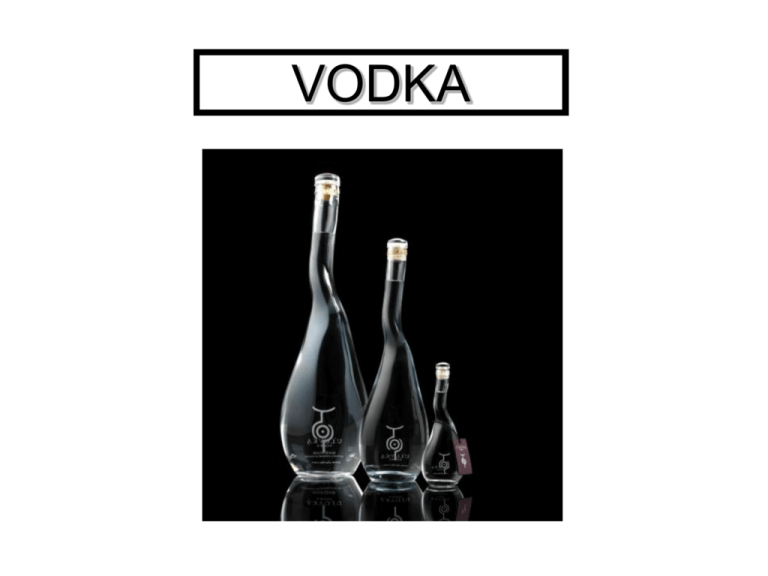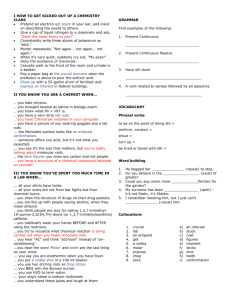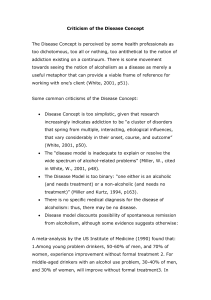vodka - Food and Beverage
advertisement

VODKA Spirits are made from four main ingredients: 1. Base Ingredient — A sugary or starchy base ingredient, whose sugars can be fermented, as in the process of making beer or wine. 2. Yeast — A single-celled organism that converts the sugar from starchy or sweet base ingredients into alcohol. 3. Water — As with brewing, local water is frequently a key factor in the quality and style of the spirit, especially for grain-based spirits such as whisk(e)y and vodka. 4. Flavorings — Some spirits owe their character to the addition of distinctive flavoring ingredients. These can include herbs, spices, honey, fruits, and vegetables. The sky’s the limit PROFILE Vodka originated in the Nordic countries and Russia in the 14 th century. The name vodka is derived from the Polish phrase, meaning the “water of life.” INGREDIENT: Traditionally vodka was made from the cheapest and most plentiful starch available locally — originally potatoes in Russia and Poland. Most commercial vodkas today are based on grains such as barley, rye or wheat (potato vodka remains as a specialty style). PRODUCTION: Most vodkas are distilled repeatedly in a continuous still to achieve the clean, neutral taste that makes them such popular mixers. To further enhance the flavor purity, many vodkas are refined by charcoal filtration, leaving only the slight scent and flavor. Flavoring essences such as fruits and spices may be added at this point to make them flavoured vodkas. CLASSIFICATION Although there are no official classifications, many vodkas tout the quality of the grain or water source used, and their purity owed to multiple distillations and painstaking filtration. AGEING: Vodka is almost always bottled without aging. PURPOSE: The ultimate mixer, vodka plays a starring role in many classic cocktails including the Martini, the Screwdriver, the Cosmopolitan and the Bloody Mary. . MIXOLOGIST TIP: To properly mix a Bloody Mary, “roll it” before you garnish: build the ingredients with ice in your mixing or serving glass, then pour the entire mixture into the metal half of your mixing tin, then back into the glass. This distributes the vodka and seasonings, for a better-tasting drink. (But, don’t shake — shaking tomato juice creates an unappetizing froth.) FLAVOURS OF VODKA: Some popular vodka flavors: Apple * Berries (currant, raspberry) * Citrus (lemon, lime, orange) * Peach * Pepper * Vanilla, Pepper(Pertsovka) DUE VODKA Wine Flavoured Vodkas – Italian made – DUE means two in Italian – Grain and Grape Made From Comes From Classification / Cocktails Ageing Brand Names Grain — mostly rye, wheat, barley. Potatoes are also traditional but uncommon. By legal definition, colorless, odorless and tasteless; however, many brands add back flavors (e.g. fruits, spices) Traditionally Russia; also Poland and other parts of eastern Europe. Now produced in most spirit producing countries No official classification but many brands promote the number of distillations as an indication of purity. Not aged Absolut Belvedere Chopin Danzka Finlandia Grey Goose Ketel One SKYY Smirnoff Stolichnaya Vox Zubrowa Bay/Sea Breeze Black/White Russian Bloody Mary Cape Cod or Codder Cosmopolitan Fuzzy Navel Kamikaze Madras Martini Screwdriver Sex on the Beach How to taste vodka. or ... "You have nothing to lose but your ice!" Preparation To begin with, vodka should be frozen. Specifically, it should be stored in the freezer overnight, or at least for a few hours. This will bring the liquor to its proper consistency and flavor. "On the rocks"? NO. Alcohol is nature's anti-freeze. Pour vodka over rocks and the rocks melt. Drinking. Vodka has become so popular because many consider it the "perfectly neutral" base for mixed drinks. Get yourself a nice 2-3 oz., clear glass. Pop in in the freezer for an hour. Then pour in a healthy shot of your frozen vodka. Let the vodka warm up just very slightly, holding the glass in your hand. This will take just a bit of the freeze off it. If vodka is too cold, it will freeze your taste buds and you will not get an adequate tasting. If it is too warm, the flavor mix becomes too complex. Tasting. There are three senses involved in a tasting of vodka: smell, sight and taste. First taste by sipping, letting the vodka rest on your palate while exhaling through your nose. Then swallow and take note of the aftertaste. Second, after cleaning your mouth (lukewarm water is the best), try downing the rest of the shot you poured (or pour another shot) "straight down," without letting it linger on your palate this time. Compare these two experiences and the aftertaste. Third, taste the vodka with some food, especially breads, potato dishes, salty dishes and fish. This will help round out your sensations and impressions of the vodka. ... Appearance. Packaging and presentation are also important criteria. Does the bottle have a cork or a twist-off cap? How well does the cap seal the bottle? Does the packaging match up with the impression the company is trying to convey of the brand? Does it give a "premium" feel? Is it stylish and attractive? Is it glass (don't even get us started on plastic bottles!)? Don't think this is all that important? Think again. The average consumer going into a liquor store or staring across a bar at a vodka bottle can only judge a vodka by its bottle! Packaging can contribute to or subtract from the overall experience mightily





